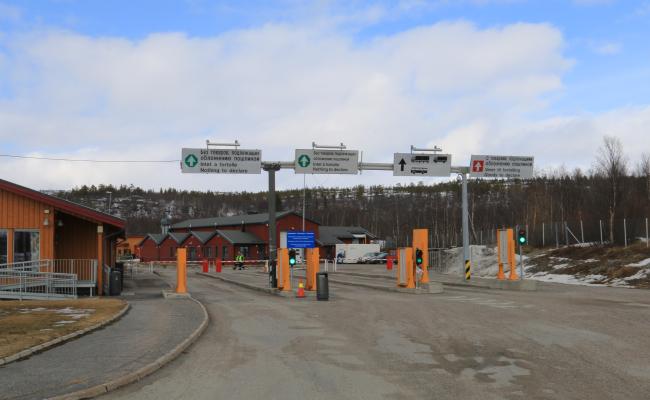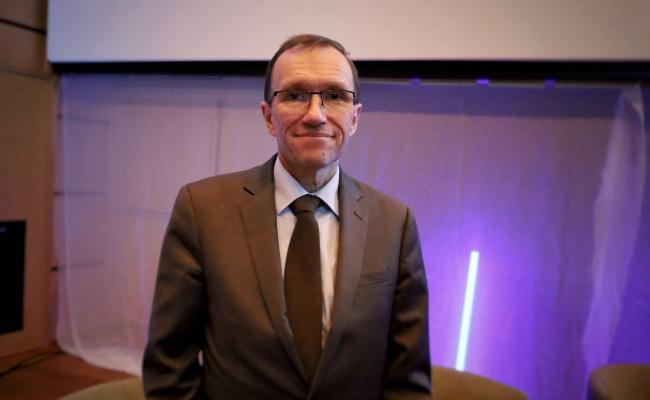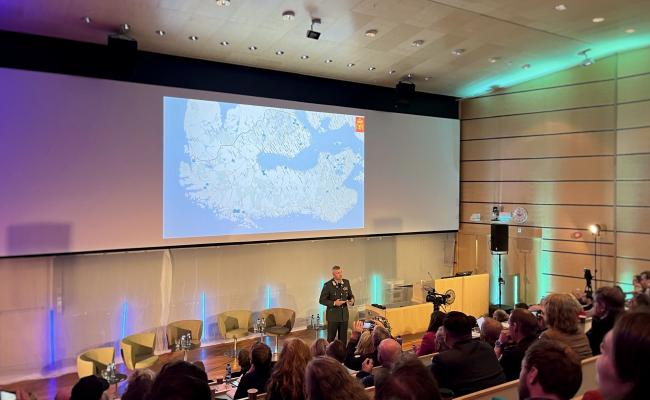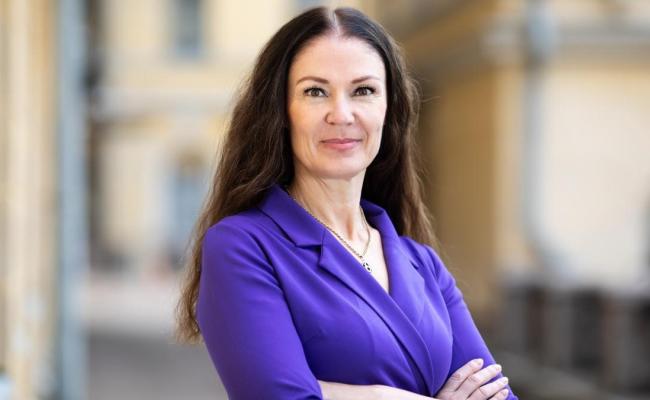Finland to Strengthen Regions Along Border With Russia
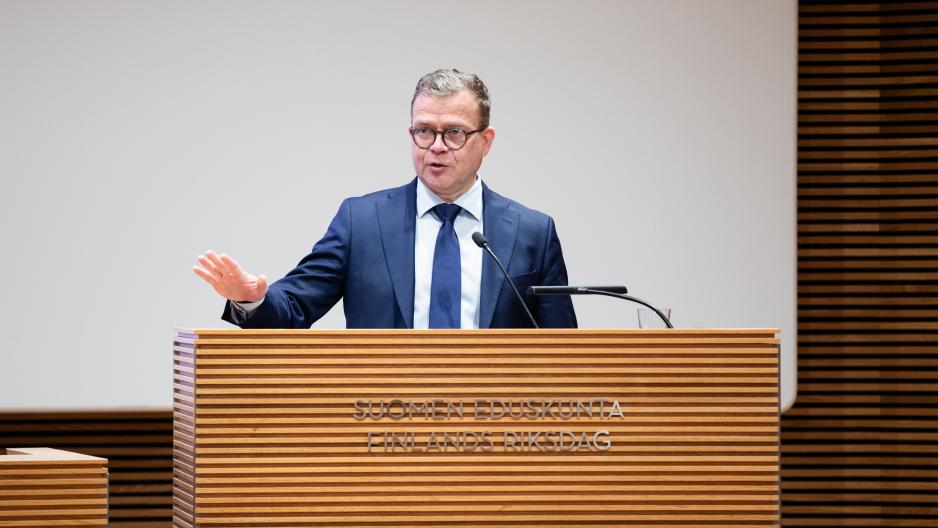
The Finnish government seeks new solutions for strengthening the growth and vitality of regions along the country’s border with Russia. Here, Prime Minister Petteri Orpo is opening a recent initial seminar on governmental programs for Northern and Eastern Finland. (Photo: Aapo Riihimäki/the Finnish government)
New geopolitical and economic challenges highlight the significance of security and vitality in Northern and Eastern Finland, says the Finnish PM Petteri Orpo. Initiatives are now being developed to enhance growth, available expertise, and preparedness in the border regions. Further border security measures are also in the works.
"Finland will manage when the whole country is managing. Therefore, we must secure the vitality of the whole country. Each region's opportunities must be fully exploited to contribute to expertise, employment, entrepreneurship, and prospects all over Finland. Naturally, this also applies to the greatest extent to Eastern and Northern Finland as well," says the country's PM Petteri Orpo (National Coalition Party).
His cabinet has now initiated the preparations for initiatives to strengthen activity and security in the two regions bordering Russia.
By the end of 2024, preparatory groups and delegations will design proposals for programs for Northern Finland and Eastern Finland, containing concise and tangible measures.
On Thursday, an initial seminar for this work was organized in Helsinki, where the prime minister gave the opening speech.
"The new challenges within geopolitics and economy and the long, shared border with Russia highlights the significance of both security and vitality in both regions. The government is set on supporting the preparation and the implementation of the programs for Eastern and Northern Finland," maintains Orpo.
Objectives
The aim of the programs is to stimulate full exploitation of the opportunities in these parts of Finland – particularly regarding economic growth, regional vitality, acceleration of investments, expertise development, and the availability of labour.
"In addition, the aim is to promote Finland's supply preparedness and self-sufficiency in the changed security policy situation and strengthen security in the Nordic, EU, and NATO cooperation in a way that considers the new geopolitics and our connections westward," informs the government.
The EU Commissioner for Cohesion and Reforms, Elisa Ferreira, sent a video greeting to the seminar participants, in which she highlighted the importance of European cooperation.
The European Commission has committed to support the regions in Finland and will provide tailor-made technical expertise to the strategic work for the border areas through the Technical Support Instrument (TSI).
The programs are to consist of specific measures to:
• Promote opportunities for sustainable growth and new investments, in addition to strengthening Finland's competitiveness and the regions' vitality.
• Exploit the opportunities sustainably with clean energy and support digital and clean growth.
• Improve the attractiveness of the regions in terms of sustainable tourism.
• Promote the development of competence and access to competent labor.
• Strengthen security, supply preparedness, and level of self-sufficiency in Finland.
• Increase the regions' physical and digital availability.
Emphasis on a Nordic framework
Northern Finland includes the administrative regions (maakunta/landskap) of Lapland, Kainuu, North Ostrobothnia. Perhaps Central Ostrobothnia is also included in this context.
The vitality of the North is becoming increasingly important for the country as a whole in the new geopolitical situation, underlines Riikka Slunga-Poutsalo. She is the State Secretary to Minister of Finance Riikka Purra and heads the delegation for the Northern regional program.
"Industrial competence, green energy, and the mentality in the North make it possible – with the support of regional actors, the government, Nordic and EU cooperation – to increase the effect of investments and thus form a globally important growth zone which strengthens the whole of Finland's competitiveness crucially," says Slunga-Poutsala and continues:
"The program for Northern Finland is intended as a tool that coordinates the measures in the Northern region with a more extensive co-Nordic frame of reference."

Northern Finland can become a growth zone of global significance, states State Secretary Riikka Slunga-Poutsalo, who heads the delegation for the program to strengthen the northern region. (Photo: Aapo Riihimäki/ the Finnish government)
This Wednesday, Finland's Minister for Foreign Trade and Development Ville Tavio (Finns Party), visited Oslo to meet Norway’s Minister of Trade and Industry Cecilie Myrseth (Labour). A central topic for their discussions was the possibilities for more cooperation in the North between the two countries.
“Nordic cooperation is important for both Finland and Norway and the bilateral opportunities are also increasing in several sectors, such as logistics, defense and trade. It is very important that the northern regions, which have great international potential to offer, retain their vitality,” Tavio says.
A good basis
Eastern Finland consists of the administrative regions of North Korelia, North Savo, South Savo, South Karelia, and Kymenlaakso.
Significant potential for growth can also be seen in the East, as Risto Artjoki, State Secretary of the PM's Office and head of the delegation for the program for Eastern Finland, points out.
"Eastern Finland has a good basis for attracting investments within industry and digitization, as well as strengthening vitality and growth in other ways. Clean energy, industrial expertise, active entrepreneurship, and opportunities for regional cooperation are important building blocks for the region's future," says Artjoki.
The seminar in Helsinki gathered a total of over 80 people who participate in the design of the regional programs – both in the delegations and in the preparatory groups.
The group for the Northern Finland Program is led by Harri Martikainen, Director General of the Government Strategy Department at the PM's Office. Tiina Korhonen, Director General of the Regions and Growth Services Department at the Ministry of Economic Affairs and Employment, leads the group for the Eastern Finland program.
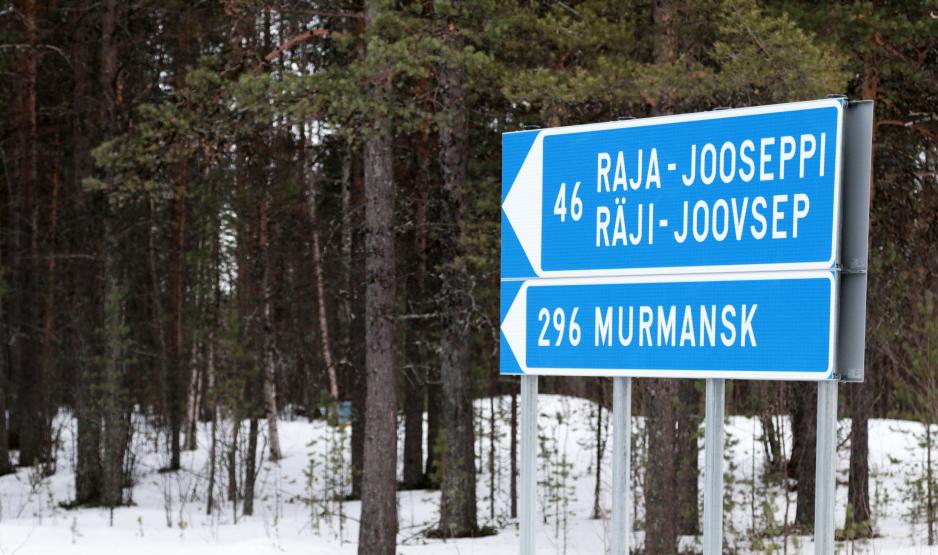
Finland is keeping its border with Russia closed until further notice as Finnish authorities still consider the threat of instrumentalized migration from the Russian side to be high. Here is a sign near Raja-Jooseppi, the northernmost border crossing between the countries. The border station is located about 242 kilometers, about a 3,5 hour drive, from the city of Murmansk in Northwest Russia. (Photo: Arne O. Holm)
Border with Russia still closed
In the fall of 2022, Finland introduced entry restrictions for Russian citizens, aiming for a full stop in tourist traffic and related transit from Russia.
In November 2023, the Finnish government decided to close the entire 1340-kilometer-long border with Russia. This measure was taken in response a migration wave that was considered to be controlled by Russian authorities, as well as other actors connected to international crime.
Since then, some border crossings have been attempted to re-open, but these were quickly closed again.
The eastern border will be held closed until further notice, informed the Finnish Ministry of the Interior on April 4th, and this is still the case.
The reason given is the persistent risk of instrumentalized migration from the Russian side, which is considered a threat to Finland's national security and public order.
“Finnish authorities see this as a long-term situation. In Russia, there are hundreds, if not thousands, of people near Finland's border who can be instrumentalized and sent to Finland,” said the Minister of the Interior Mari Rantanen (Finns Party) in April.
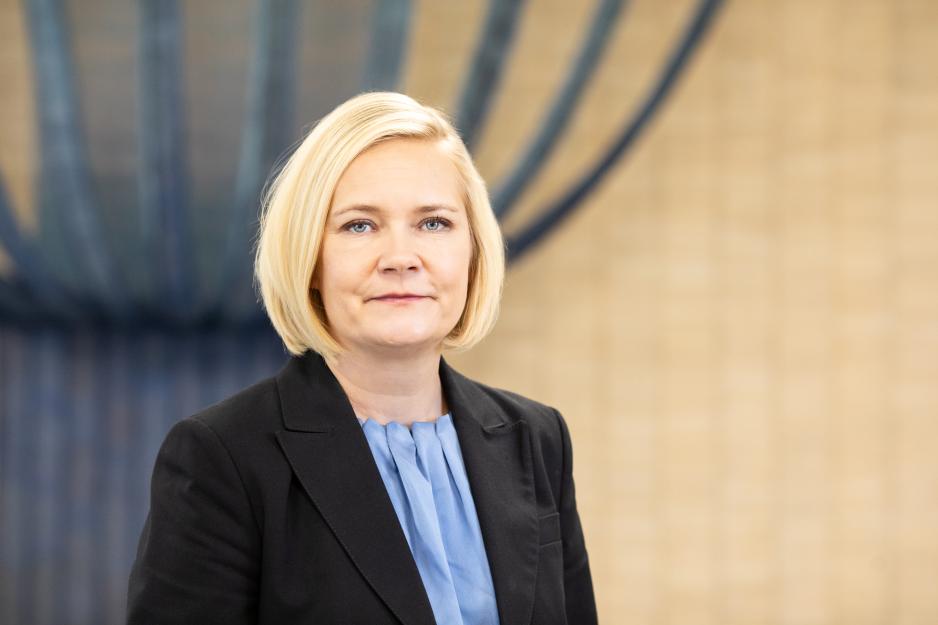
Russia uses instrumentalized migration to influence Finland and the EU's security and social stability, maintains the Finnish Minister of the Interior Mari Rantanen. Since this fall, she has taken several measures to prevent Russian hybrid operations over the border. (Photo: Fanni Uusitalo/the Finnish government)
Proposal for a border security act
Recently, the Finnish government proposed a border security act on temporary measures to combat instrumentalized migration and ensure the country's sovereignty and national security.
The legislative proposal includes provisions on the conditions under which the government could decide to restrict the reception of applications for international protection in a limited area on Finland's national border and in its immediate vicinity. Such a decision would be made following prior cooperation with the President of the Republic.
The proposal can be considered a limited derogation from the Constitution. Applying the act will require highly exceptional and pressing reasons, and decisions on said restriction can only be made for a maximum of one month at a time.
The idea is that the border crossings at the eastern border can be open to other traffic if the situation permits, although reception of asylum applications is limited for a certain period, according to the Ministry of the Interior.
The government proposes to the parliament of Finland, Eduskunta, that the act enter into force as soon as possible with a duration of one year. The proposal is now being considered by the parliament's administrative and constitutional committees.
Cooperation in the EU and along the outer borders
At the same time as the Finnish government wants the new border security act to efficiently intervene nationally in situations where instrumentalized migration is utilized to exert pressure on Finland, the aim is also to find solutions at an EU level to counter this phenomenon.
Rantanen discussed this with her colleagues in Estonia, Latvia, Lithuania, Poland, and Norway during a meeting of the interior ministers in Riga from May 23rd to 24th. Norway was represented by State Secretary Even Eriksen (Labor) in the Ministry of Justice and Public Security.
The meeting's overarching agenda was dialogue on the countries' shared security challenges at Schengen's outer borders with Russia and Belarus.
The ministers agree that EU measures are needed against instrumentalized migration, and they consider it important to have extensive cooperation between the six states along the outer borders on matters of border security. They also want to cooperate on civil preparedness, reports the Finnish Ministry of the Interior.
“We agreed to develop and strengthen our countries' preparedness for crises and civil preparedness and to share information and good practices in this field. For example, our civil defense shelters are an important long-term investment in Finland's comprehensive security. We have a great deal of civil defense expertise that we would like to share with the other countries on the EU's external border,” Rantanen says.
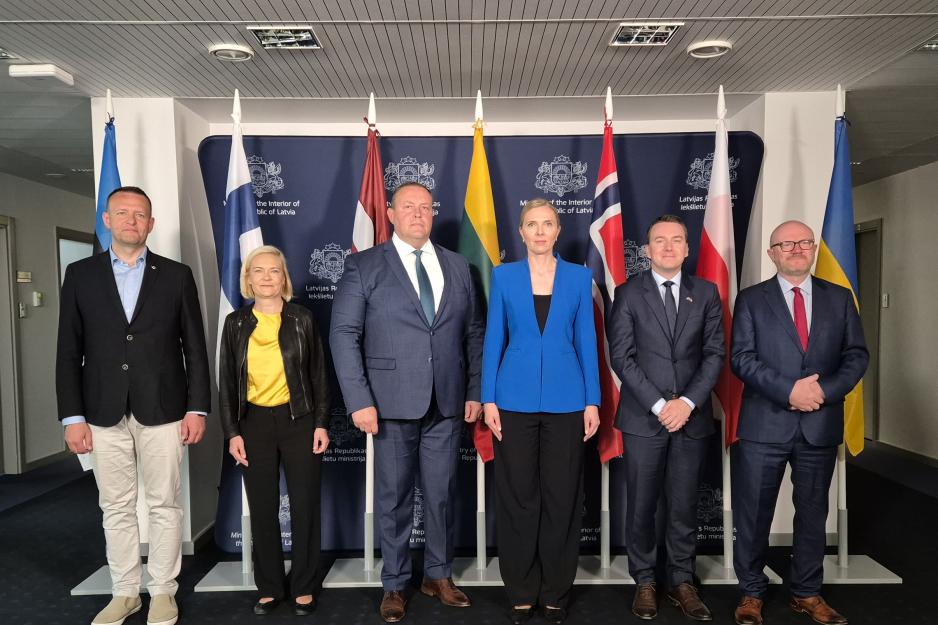
Meeting of Ministers of the Interior in Riga, Latvia. From left: Estonia's Minister Lauri Läänemets, Finland's Minister Mari Rantanen, Latvia's Minister Rihards Kozlovskis, Lithuania's Minister Agnė Bilotaitė, Norway's State Secretary Even Eriksen, and Poland's State Secretary Maciej Duszczyk. (Photo: Latvian Ministry of the Interior)
Border fence under construction
In the meantime, an about 200-kilometer-long barbed wire fence is being constructed along Finland's border with Russia. Eduskunta decided to erect it in 2022. The purpose is to make border surveillance more efficient.
Construction of the fence began in February 2023, and it is scheduled to be completed in 2026. The main part will be built along the southeastern border, the focus area for border surveillance.
The pilot phase, which involved the construction of an approximately three-kilometer-long fence in the border town of Pelkola, South Karelia, was completed in the fall of 2023.
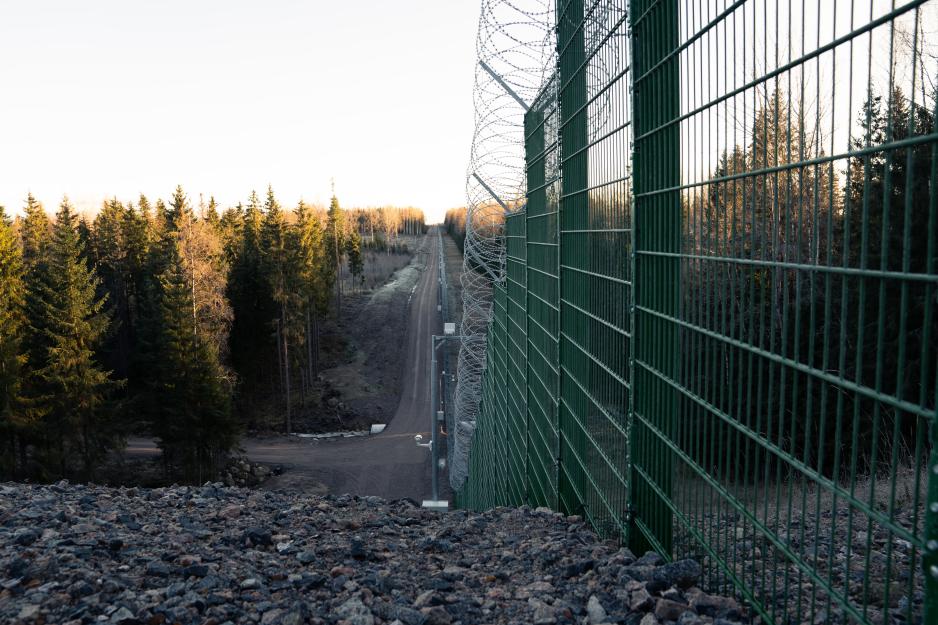
The pilot fence in Pelkola by the Finnish-Russian border. With its 1340-kilometer, this is the EU and NATO's longest outer border with Russia. (Photo: the Finnish Border Guard)
Other new measures
Finland's government is also well underway with other measures to strengthen preparedness and surveillance at the eastern border:
• The law regarding the Border Guard's administration and the Border Guard Act have been amended. The purpose is more flexible utilization of personnel resources and to ensure the Border Guard's functional capacity in the event of disturbances under normal conditions. Through the changes, the Border Guard's preparedness to ward off hybrid threats will also be deveoped. The reformed legislation was adopted by Eduskunta and confirmed by the president in May for entry into force on June 15th.
• On May 23rd, the government proposed allocating 11 million euros for the construction and operation of a new radio technical monitoring system for the Border Guard. This measure is part of the government's proposal for Finland's second supplementary budget for 2024. With radio technology, the Border Guard can detect, locate, recognize, specify, and monitor radio frequency electromagnetic waves and radio equipment.
• On June 6th, the government submitted to parliament a proposal on changes to the Conscription Act to ensure border security. If it is adopted by Eduskunta, the Border Guard can get flexible help from reservists in the military border troops in particularly difficult situations on the border.
Surveillance balloons and border statement
On its part, Russia has started using surveillance balloons to monitor areas by the border with Finland, reported Yle last week.
A desire for unilateral border changes vis-à-vis Finland and Lithuania in the Baltic Sea has also recently appeared in a document published by the Russian Ministry of Defense. The document was removed from the ministry's website last Wednesday. The purpose of the whole thing may have been to create unrest and fear, writes NRK Urix.



